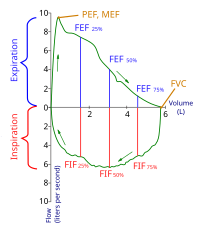
Photo from wikipedia
Assessment of congestion and cardiac function has been shown to have both therapeutic and prognostic implication for the management of patient with CHF. Pulmonary transit time (PTT) assessed by cMR… Click to show full abstract
Assessment of congestion and cardiac function has been shown to have both therapeutic and prognostic implication for the management of patient with CHF. Pulmonary transit time (PTT) assessed by cMR is a novel parameter, which reflects not only hemodynamic congestion but also LV and RV function. We sought to explore the prognostic value of the pulmonary transit time assessed in seconds (PTT) and in beats (PTB) and the pulmonary blood volume indexed (PBVi) above conventional well-known risk factors including cMR-RVEF and estimated pulmonary artery pressure (eSPAP) in predicting outcomes. PBVi is defined by the product of PTB and the stroke volume indexed to body surface area. 401 patients in sinus rhythm with a LVEF <35% (age 61±13 years; 25% female) underwent a cMR and an echocardiography. Patients were followed for a primary endpoint of overall mortality. Average cMR-LVEF was 23±7%, cMR-RVEF was 43±15%, average estimated systolic pulmonary pressure (eSPAP) was 33±12mmH, average PTT was 11±6s, PTB 8.9±5.6 bpm and average PBVi 305.5±254.9ml/m2. After a median follow-up of 6 years, 182 reached the primary endpoint. In univariate cox regression, age, ischemic cardiomyopathy, hypertension, diabetes, NYHA class III-IV, eSPAP >40mmHg, E/A ratio, e/e'ratio, cMR-RVEF, LV scar, PTT, PTB, PBVi, GFR, beta blockers and diuretics were associated with overall mortality. For the multivariate analysis, a baseline model was created where age, ischemic etiology, NYHA functional class III-IV, eSPAP >40 mmHg, beta-blockers and cMR-RVEF were found to be significantly and independently associated with the primary endpoint. PTT (X2 to improve = 5.3, HR: 1.03; 95% CI: [1.01; 1.06]; P=0.015), PTB (X2 to improve = 11.8, HR: 1.06; 95% CI: [1.03; 1.09]; P<0.001) and PBVi (X2 to improve = 7.7, HR: 1.08; 95% CI: [1.03; 1.14]; P=0.002) showed a significantly additional prognostic value over the baseline model (p<0.001). Pulmonary transit time and pulmonary blood volume provide higher prognostic information over well-known risk factors including cMR-RVEF and eSPAP with high power to stratify prognosis in HF-rEF and might be promising tools to identify patients at higher risk among HF patients. Fond National de recherche scientifique (FNRS)
Journal Title: European Heart Journal
Year Published: 2019
Link to full text (if available)
Share on Social Media: Sign Up to like & get
recommendations!